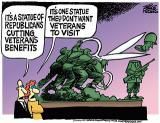January 28, 2015 - Ask Americans if someone in their family served in the military, and the answer is probably no. After all, fewer than 1 percent of Americans serve these days.
But ask if one of their grandfathers served, and you'll likely get a different answer. Between World War II and the wars in Korea and Vietnam, millions of men were drafted into service — and both men and women volunteered.
Now, that generation of veterans is getting older. And as many of them near the end of their lives, aging into their 80s and 90s, the demand for hospice care has been growing with them. That means that the Department of Veterans Affairs is spending a lot more on what's known as end-of-life care.
"I think they call it end-of-life care," notes Thomas O'Neil, a 68-year-old resident at the St. Albans VA hospital in Queens, N.Y. "But whatever it is ... they treat you like gold. If you're going to be sick, this is the place to be."
O'Neil served a year in Vietnam, from 1966 to 1967, at a time when the war was killing more Americans in a year than the total casualties from Iraq and Afghanistan combined. read more>>>























No comments:
Post a Comment